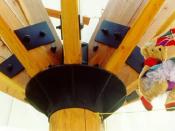Vermont Teddy Bears: EAFS/IFAS
Introduction
Vermont Teddy Bears (VTB from here on) was created by John Sortino in 1981. John had noticed that most of his child's stuffed animals were made in other countries. John had decided to created bears that were of high quality and made in the USA. He sold his wares from a push cart on the streets in Vermont. His business grew with the addition of homesewers. John, by questioning his customers and relying on their feedback, realized that the purchasers wanted bears that were "...machine washable... [jointed]...safe for children... (and had) personality (Wheelen, Hunger, 2004)."
John soon realized that his company needed another marketing channel. He used local radio stations to broadcast commercials for his bears. He used the announcers to add trustworthiness to the company name. John did not regret this decision. His business' sales rose over $4.5 million in just 3 years.
However, this success would be short lived if things did not change.
In 1994 the company experienced a financial pitfall. VTB's expenses grew, but their sales did not increase as rapidly as they had hoped. By recognizing that the company's future relied on transforming to a "...professional managed organization," John resigned and a new CEO took his place (Wheelen, Hunger, 2004). However, that CEO has been replaced as well. Elisabeth Robert took over the position of CEO in 1997. Elisabeth knew she needed to revamp the company. Costs needed to be cut, and a new image needed to be brought forward for VTB.
Elisabeth had a clear plan for the company. She realized that the customers were more concerned about the cost of the merchandise than the Made in the USA label. Some bears were still manufactured in the US using imported materials. These bears bore a new tag...

